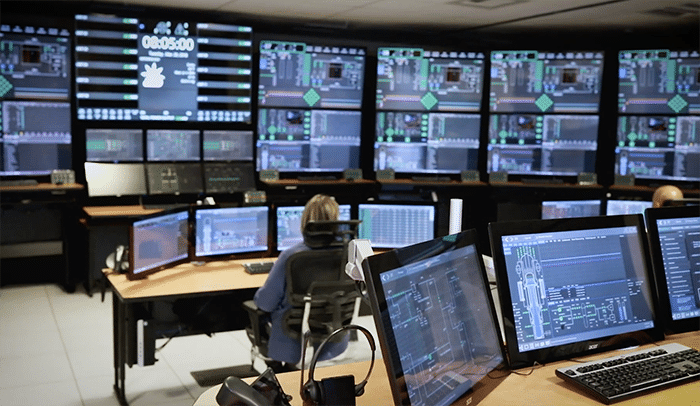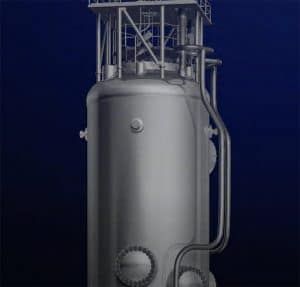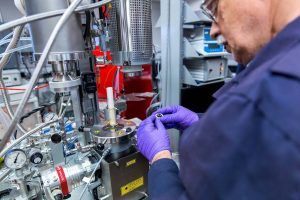Are small modular reactors the solution to climate change? Some Canadians think so.
By Charles Mandel | May 20, 2021
 Power plant control room simulator, for a small modular reactor. Image courtesy of NuScale Power/NuScale Test Facility Tours.
Power plant control room simulator, for a small modular reactor. Image courtesy of NuScale Power/NuScale Test Facility Tours.
John Gorman believes in a nuclear future—which, given his background, might come as a surprise. Before becoming president and CEO of the Canadian Nuclear Association, Gorman worked in positions where he championed solar, wind, and hydro—renewable energy sources with a lot less baggage.
But make no mistake, Gorman views the ongoing development of nuclear energy as vital to battling the climate crisis and lowering Canada’s greenhouse gas emissions. Many other environmentalists reject nuclear over concerns about the disposal of nuclear waste, radioactive fallout, and the length of time it might take to develop the technology.
Not Gorman.
“Canada is the poster child for approaching nuclear the right way as we approach a net-zero future,” he recently told Canada’s National Observer.
Canada’s existing nuclear power is produced by 19 CANDU reactors (a type of fission reactor developed in Canada that uses deuterium oxide as a moderator and uranium as a fuel), which supply 15 per cent of the country’s total electricity. Ontario hosts 18 of the reactors, while New Brunswick has one at Point Lepreau. Two of the Ontario plants, Darlington and Bruce, are being refurbished. The industry as a whole employs 76,000 people and contributes $17.6 billion in Canadian dollars to the economy annually, Gorman says.
However, Gorman, along with the rest of the nuclear industry, pins the country’s future decarbonization efforts on a new breed of nuclear power known as small modular reactors (SMRs). SMRs are portable reactors capable of generating up to 300 megawatts of electricity. They can be deployed in a variety of ways, potentially replacing large-scale diesel generators in remote mining operations, for example, or helping power off-grid communities in Canada’s North.
A feasibility study on SMRs released by four Canadian power companies in March says that with growing interest in SMRs, an exciting opportunity exists for Canada to export the technology to address global issues such as climate change and energy security.
To date, not a single SMR has been built in Canada, but no matter, the technology is the current darling of nuclear power circles, and not just at home, either; other countries, from China to the United States, are pursuing the development of SMRs. Currently, 12 proposals for SMR development are winding their way through the Canadian Nuclear Safety Commission’s (CNSC) pre-licensing vendor review process, which enables CNSC staff to provide feedback on proposed designs at a company’s request. But not a single project has yet been approved.
That hasn’t stopped the Canadian federal government from actively promoting a shift to SMRs. Seamus O’Regan, the minister of natural resources (whose department has nuclear power under its purview), said in a speech delivered to the Canadian Nuclear Association in 2020: “Our government understands the importance of nuclear energy to meeting our climate change goals… We are placing nuclear energy front and center.”
In case he didn’t make it clear enough, O’Regan added: “This is nuclear’s moment. This is your moment. To shape the next wave of nuclear technology. And move to the front lines in the battle against climate change and the plan to get Canada to net zero by 2050.”

For the time being, any vision of SMRs is largely aspirational. A Conference Board of Canada report in March on SMRs outlined that from concept to commercialization, the technology will require about a billion dollars of development expenditure. The same report noted that as an emerging technology, costs are still uncertain, and the “risky pre-commercial phase needs capital investment, but governments will be reluctant without major private capital commitment.”
It’s early days for financing the technology. For instance, one infusion of federal funds, the $50 million granted to New Brunswick’s Moltex Energy in mid-April, only supports research and development, employee recruitment and the expansion of academic, research and supply chain partnerships, not the physical construction of that firm’s SMR.
Beyond financial considerations, the Liberal government will have a tough time convincing environmentalists to embrace the merits of SMRs, or any nuclear power, as a clean energy source. More than 100 groups have signed a letter issued by the Canadian Environmental Law Association condemning the government’s push to pursue nuclear power and SMRs. Among their concerns are that SMRs are more expensive to develop than renewable energy and that the reactors are “dirty and dangerous,” creating new forms of radioactive waste that are especially dangerous to manage.
As the SMR developments move forward, the environmental groups will have a chance to make their views heard during the public consultations that will have to take place as part of the environmental review phase of licensing each SMR.
For now, however, nothing is slowing the momentum. In mid-April, the Canadian Nuclear Association triumphantly announced Alberta was joining Ontario, New Brunswick and Saskatchewan in the development of SMRs.
Those aren’t the only recent developments in the burgeoning SMR industry. Ontario Power Generation is teaming up with SMR developer Ultra Safe Nuclear Corporation to develop a micro modular reactor at Chalk River. Ontario Power Generation is also carrying out engineering and design work on SMRs with GE Hitachi, Terrestrial Energy, and X-energy.
On its website, the CNSC also reports that 17 companies globally have requested regulatory information on SMRs. These include Westinghouse in the United States, China’s CNCC and the Korea Atomic Energy Research Institute. Canada, though, remains one of the SMR innovators and could even surpass the European Union with its new nuclear program. To be sure, Everett Redmond, a senior technical adviser with the US-based Nuclear Energy Institute, said: “I’d say Canada is running right on par with the United States in terms of looking at deployments.”
When it comes to decarbonization using nuclear as an energy source, the European Union previously led the way. France and the EU have placed more reliance than North America on nuclear power to help meet stringent renewable energy targets. France, for example, pulls 70 per cent of its energy from nuclear power.
However, there are signs Europe is now shifting away from nuclear power. In 2019, solar installed capacity exceeded nuclear for the first time in the EU, with 130 gigawatts versus 116 gigawatts, according to the World Nuclear Industry Status annual report, which provides independent assessments of global nuclear developments. And a technical expert group convened in the EU chose not to recommend nuclear energy when asked to advise on screening criteria that would substantially contribute to climate change mitigation or adaptation while “avoiding significant harm” to other environmental objectives.
Gorman views nuclear as favorable to the environment. When Ontario replaced coal-fired electricity with nuclear by 2014, it became the single largest carbon-reduction initiative in the world. “Canada is definitely a world leader in this regard,” Gorman maintains.
The elimination of coal stands as the single largest greenhouse gas emissions-reduction action on the continent and was primarily responsible for Ontario achieving its 2014 emissions-reduction target of six per cent below 1990 levels, according to the Ontario government.
Gorman compares SMRs and conventional reactors to the personal computer versus mainframe computers. The SMRs can power as little as one megawatt or as much as 300. They can be mass-produced in a manufacturing facility and scaled to different sizes. The first anticipated SMR in Canada is under development by Westinghouse and has been dubbed the eVinci Micro Reactor. The company wants to have it up and running by 2026. Westinghouse has not disclosed how much it will cost to develop the eVinci.
Westinghouse is working with Bruce Power to find applications for the micro reactor, which is described as a “next-generation small battery” that could be sold to and used in remote communities and industrial mines, among other things. It is that industrial application that particularly excites Gorman, who says according to a study the Canadian Nuclear Association commissioned, SMRs could reduce greenhouse gas emissions by 216 megatons in the heavy industrial sector—the equivalent of removing all current emissions from the oil and gas sector for a one-year period.
The eVinci is only one of a spate of projects. Oakville, Ontario-based Terrestrial Energy received $20 million in federal funding in 2020 to begin development on its SMR, which it anticipates launching in the late 2020s.
Other projects in development include a 300-megawatt SMR at the Darlington Nuclear Plant in Ontario, in conjunction with Bruce Power and Saskatchewan Power, for 2028. Four more SMRs, described as a “fleet,” would then be deployed in Saskatchewan to replace coal plants, with the first unit starting up in 2032. A five-megawatt, gas-cooled SMR is being built at Chalk River in Ontario, with service anticipated for 2026, while the Moltex project in New Brunswick is expected to come on stream in early 2030.
“We’re a world leader in terms of having advanced these technologies through the regulatory and licensing system, so Canada really is positioned to be a first mover here and it’s very exciting,” Gorman said.
The development of SMRs in Canada isn’t just a matter of happy coincidence; the federal government has been lobbying hard on behalf of the industry since at least 2019. The Department of Natural Resources, for instance, is a member of the international initiative Nuclear Innovation: Clean Energy Future, or as it’s better known, NICE. Besides Canada, members include Japan, the United States, and a number of nuclear associations. The goal “is to ensure that nuclear energy receives appropriate representation in high-level discussions about clean energy.”

Freelance researcher Ken Rubin turned up a number of documents using freedom-of-information requests that showed the federal government is collaborating with NICE and others to promote nuclear power and SMRs. The federal government, for example, offered $150,000 for the development of a “Top 20 book of short stories” on “exciting near-term nuclear innovations” designed to showcase nuclear power as an environmental force for good. The book includes stories on the safe storage of nuclear waste as well as on the emerging SMR market.
According to the book, uses for the latter technology include “energy parks” providing heat for industrial processes, steam for heating and electricity for cooling homes, offices and shops, all without emissions. The story breathlessly declares: “This isn’t science fiction.”
No matter how hard the government lobbies the public for a NICE future, though, it’s going to remain a tough sell to Canadian environmentalists. While the environmentalists have nothing specific to fight yet, given that a viable SMR has yet to be built, they’ll be ready when the technology reaches development. Already, a who’s who of groups has signed a letter protesting the next thing in nuclear.
Theresa McClenaghan, CELA’s executive director and counsel, told Canada’s National Observer: “It’s not a climate answer for many reasons, including the fact it’s not realistic and it’s way too far down the road for us to meet any serious climate targets. We’ve characterized it as a dirty, dangerous distraction.”
Susan O’Donnell, a researcher and adjunct professor in the Department of Sociology at the University of New Brunswick and a nuclear activist, says SMRs are too slow and costly as a climate crisis solution. “It’s important to remember that these technologies basically don’t exist yet,” she said. “They’re at a very early stage in development. They are speculative technologies. It will take at least a decade to get them off the drawing board and then it will take much longer than that to find out if they work.”
Faced with such criticisms, Gorman expresses frustration. He says when he first began working in the solar industry, the main criticism was that solar was an expensive science experiment that would never result in low-cost electricity, and that it was a waste of money to try and develop the technology. “And lo and behold, that’s exactly what the detractors of small modular reactors are saying.”
Gorman doesn’t dismiss renewables, calling wind and solar extremely important, but he says the challenge is to produce two to three times as much electricity generation globally compared to what’s currently available, and we only have 30 years in which to do it. He maintains that every source of clean energy will be necessary to meet the demand, including such developing technologies as SMRs, hydrogen, carbon capture and storage, and new forms of electricity storage.
“We desperately need to be developing those at the same time we’re deploying wind and solar and existing technologies so that we can bring everything to bear by 2030 as we lead into 2050.
“That’s the challenge.”
Together, we make the world safer.
The Bulletin elevates expert voices above the noise. But as an independent nonprofit organization, our operations depend on the support of readers like you. Help us continue to deliver quality journalism that holds leaders accountable. Your support of our work at any level is important. In return, we promise our coverage will be understandable, influential, vigilant, solution-oriented, and fair-minded. Together we can make a difference.
Keywords: CANDU, SMR, climage change, climate crisis, fission, global warming, nuclear energy, small modular reactor
Topics: Climate Change, Nuclear Energy
















Now I’m trying to come up with “Modular” to the tune of “Popular” (from Wicked).
For Canada nuclear MIGHT make sense if they can bring the price down a LOT. But, theoretical cost reductions are just that until you deploy and run for a few decades. In a few decades, commercial solar daytime only (no battery storage) will be so silly cheap that in places like Houston it will make economic sense to create clean burning, carbon neutral, synthetic diesel (or methane) from seawater and electricity, and ship it to Canada to run their power plants – rather than using nuclear, which I suspect will STILL be more expensive. Using the Navy’s processes, 8 years… Read more »